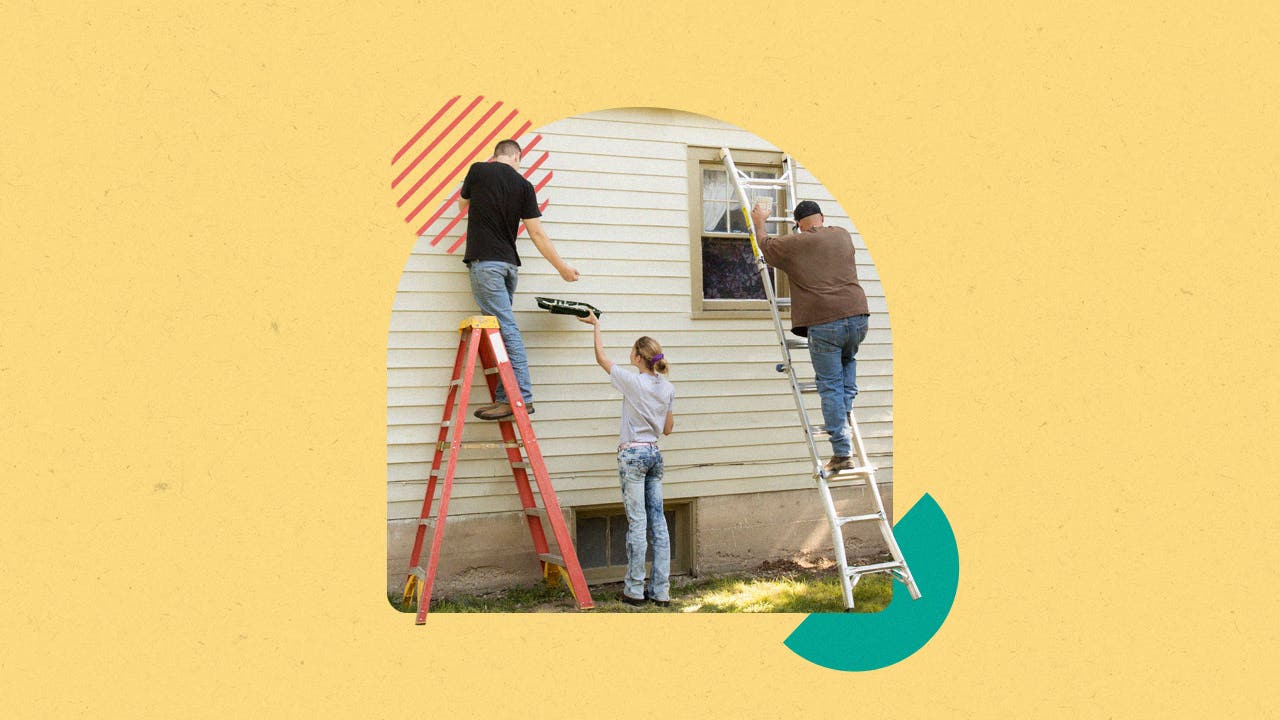Mortgages and loans to pay for home renovations

The Bankrate promise
At Bankrate we strive to help you make smarter financial decisions. While we adhere to strict , this post may contain references to products from our partners. Here's an explanation for .
Key takeaways
- There are multiple renovation loan options for people who want to borrow money to improve or renovate their homes. Some loans let you finance a home purchase and renovation at the same time.
- Loans that use your home as collateral, including home equity loans and HELOCs, can have tax advantages.
- Loans that don’t rely on home equity are also an option but typically have higher interest rates.
Whether you’re looking to renovate your kitchen, install a home office or finish your basement, any major home improvement is going to require some major money. A home renovation loan could be your path to getting the project underway sooner than you think. This guide outlines funding options for your home upgrades and how to get a renovation loan.
What is a home renovation loan?
A home renovation loan is a form of financing that includes funds for upgrading, remodeling and repairing a home. Something of a generic term, it can be like a regular personal loan, but it often takes the form of a secured debt, too — specifically, a loan of some sort that uses the home you’re aiming to improve as collateral.
More specifically, a home renovation loan can be:
- A purchase mortgage, with additional money for home improvements
- A mortgage product backed by a government agency or government-sponsored enterprise that includes funds to purchase and upgrade a residence at once
- A refinance of your current mortgage with a cash payout
- A home equity loan or line of credit (HELOC)
- A personal loan, sometimes referred to as a home improvement loan
Some home renovation loans or refis require the borrower to have a certain amount of equity in the home (the main exception being personal loans, which are typically unsecured).
When should you consider a home renovation loan?
There are several scenarios where you may want to consider a home renovation loan, including:
- Insufficient funds – Your home needs an urgent repair (a plumbing issue, for instance) or is on the verge of needing one (sinking foundation) and you do not have the cash on hand to pay a contractor. Or, it’s a discretionary undertaking, but you don’t want to blow your budget or deplete your savings account for it.
- Fixer-upper – If you have fallen in love with a fixer-upper or as-is home — one with a low asking price that needs serious work — some home renovation loans can provide funds to purchase and restore the residence.
- Build home equity – One key way to increase the worth of your ownership stake in your home (besides paying down your mortgage) is to improve the home itself. Strategically-selected renovations can be a smart investment, improving your property value and making your home a more comfortable place to live.
- Boost fair market value – If you are looking to list your home, nothing adds a competitive market edge like projects that expand the habitable space or keep the home up-to-date and functional.
Whatever your motivation, keep a sense of the home’s worth in mind. “I would only recommend taking out a renovation loan if the costs of the renovation are still well below the current value of the home,” says Gregg Harris, president of LenderCity Home Loans in Chesterfield, Missouri. “It is also important that they will positively impact the value of the home over the long run. So, things like bathrooms, kitchens and additions make the most sense.”
Home renovation loan options
| Loan type | When to use | Minimum credit score | Additional considerations |
|---|---|---|---|
| Fannie Mae HomeStyle | For any project | 620 | Renovation costs limited to 75% of expected value of the property after reno |
| Freddie Mac CHOICERenovation loan | To purchase and renovate a new home or fund renovations on an existing home | 620 (depending on lender) | Repairs or renovations cannot exceed 75% of appraised value of home after upgrades made |
| FHA 203(k) | For many projects, but they can’t be luxury renovations and must be for your primary home | 580 | Must be borrowing at least $5,000, and project must be completed within 6 months |
| Home equity loan/HELOC | For any project, but tax advantages if for the home | Varies by lender | Might pay extra fees to close, but interest rates tend to be competitive |
| Cash-out refinancing | For any project | Varies by lender | Need at least 20% equity to qualify and must pay closing costs |
| Personal loan | For any project | Varies by lender | Some loans capped at $50,000; interest rates tend to be higher |
Fannie Mae HomeStyle Renovation loan
The Fannie Mae HomeStyle Renovation loan allows borrowers to either buy a place that needs repairs or refinance their existing home loan and get money for improvements.
One advantage of a HomeStyle loan is that it’s a single debt with one monthly payment; you don’t have to take out a loan for the mortgage and another loan for home repairs. Getting one loan cuts down on time and closing costs.
The loan money goes into a separate escrow account that’s used to pay contractors. Borrowers do not have access to those funds.
You can use the Fannie Mae HomeStyle loan to improve a vacation home or investment property, and any renovation or repair is eligible for funding, as long as it’s permanently affixed to the property and adds value to it.
-
- Homeowners can borrow money to improve their property. In this way, the loan is an investment that could boost the home’s value.
- You can qualify with a down payment as low as 3 percent if you’re a first-time buyer getting a fixed-rate loan and you plan to live in the home.
- It may feature lower interest rates and shorter repayment terms than conventional improvement loans.
- It conveniently includes the home loan’s principal amount and home renovation funds in one loan with one set of closing costs.
-
- Renovation costs are limited to 75 percent of the “after-repaired value” of the home. Manufactured home renovations are limited to the lesser of $50,000 or 50 percent of the “after-repaired value.”
- Renovations must be completed within 12 months from the date your loan closes.
- Borrowers can’t directly access funds.
- There’s more onerous paperwork, and it usually takes longer for money to come through than with conventional loans.
-
Despite financing both your home’s principal debt and renovation, the Fannie Mae HomeStyle refinance loan is only one loan with one set of closing costs. Fees and closing costs may be higher than other types of mortgages. However, through Fannie Mae’s Community Seconds program, you may be able to borrow up to 5 percent of your home’s value to help cover the down payment and closing costs.
-
In a competitive real estate market, a Fannie Mae HomeStyle Renovation loan may not be ideal if you’re looking to secure a deal fast. These loans require some extra work upfront before your loan is approved — and before you can even submit an offer on a home. For example, your contractor must establish a construction schedule and plans for your renovation. You must also submit a property appraisal known as an “as-completed” appraisal.
Freddie Mac CHOICERenovation loan
CHOICERenovation is a loan option provided by Freddie Mac that allows you to finance your home purchase and renovation expenses with a single loan. It’s also ideal for homeowners interested in a no-cash-out refinance solution to enhance or repair their current property.
This loan option allows you to finance renovations up to 75 percent of the home’s post-improvement value. The renovations must be to an existing home.
Among the eligible property types allowed are one- to four-unit primary residences, manufactured homes and second homes. One-unit investment properties, units located in planned unit developments and condos are also eligible.
For smaller-scale projects, Freddie Mac also offers the CHOICEReno eXPress Mortgage loan. Renovations must be completed within 180 days of the mortgage note date. If your home’s location is deemed a Duty to Serve high-needs area, you could get up to 15 percent of the home’s value in funds for renovations.
-
- Available for primary homes, second homes and investment properties
- Provides the convenience of financing a home purchase and renovations with a single fixed-rate or adjustable-rate loan
- Can include resilience upgrades to protect existing homes from natural disasters
- Supports the construction of accessory dwelling units, such as mother-in-law apartments
- Combined with Freddie Mac’s Home Possible or HomeOne programs allows home purchases with 3 percent down
-
- Not all lenders provide CHOICERenovation loans
- Repairs and renovations are limited to a maximum of 75 percent of the lower amount between the purchase price plus renovation expenses and the post-renovation value of the property
- Funds cannot be used to demolish an existing structure and construct a new dwelling or to pay for items not permanently affixed to the property (except new appliances)
- Second homes have a higher loan-to-value requirement (90 percent), while investment properties require an 85 percent LTV
-
Closing costs can range from 2 to 5 percent of the loan amount, but you’ll only need to pay one set of closing costs.
-
Before granting your mortgage application, the lender will evaluate your financial status and proposed renovation plans.
Upon approval, you’ll need to establish an escrow account to hold funds for renovations, reserves for unexpected expenses and provisions for up to six months of mortgage payments. These funds are securely held until the closing, with payments to your contractor being made in stages as the work advances. After the closing, the lender may opt to release up to half of the material expenses.
FHA 203(k) loan
Like Fannie and Freddie’s offerings, the FHA 203(k) loan — a government-backed conventional rehab loan — funds the home purchase and its renovations. The Federal Housing Administration insures this loan, and its goal is to create more options for homeowners or buyers of homes that need rehabilitation and repair.
Multiple home types are eligible for 203(k) loans. These home types include single-family homes, 2-4 family unit homes, mixed-use properties that are primarily residential, and manufactured homes titled as real estate.
There are two types of FHA 203(k) loans:
- Limited 203(k) loans are capped at $35,000.
- Standard 203(k) loans are for major rehabilitation or construction.
-
- Income and down payment requirements are less stringent than other types of mortgage loans.
- One mortgage covers the purchase of your home and renovations.
- It includes a minimal down payment, as low as 3.5 percent.
- You may be eligible for a larger tax deduction (the larger loan combines renovation and home purchase).
-
- Mortgage insurance premium (MIP) is required.
- You must use it for a primary residence only.
- Any remodeling is limited to the FHA’s list of eligible projects.
- The process involves more paperwork than other types of mortgage loans.
-
Closing costs generally range from 3 to 5 percent of the purchase price.
-
If the process of getting an FHA 203(k) loan seems overwhelming, take comfort that a qualified 203(k) consultant will guide you every step of the way.
Also, as much as you want to get started remodeling the kitchen or another part of your home, the lender will require you to address all safety and health hazards first, such as lead-based paint, termites and broken windows.
The FHA 203(k) loan has a long list of eligible improvements, such as replacing a roof, flooring and plumbing, removing safety and health hazards and upgrading to accommodate a person living with a disability. However, the loan can’t be used for a luxury/purely discretionary improvement, such as building a backyard swimming pool or tennis court. The loan is also only for primary homes, not second homes or vacation residences.
Home equity loan/HELOC
A home equity loan is a fixed-rate, lump-sum loan with monthly payments that remain the same for the loan term. A home equity line of credit, or HELOC, has a credit limit and revolving balance. This loan works well for homeowners who have several large contractor payments due over time on a big home improvement project.
Generally, you’ll receive one lump sum payment with a home equity loan, while HELOCs have a draw period of five to 10 years, during which you can access funds.
-
- These options have competitive interest rates, especially compared to personal loans/credit cards.
- Home equity loans come with fixed interest rates and payment amounts that remain the same for the life of the loan.
- With a HELOC, you can draw funds as you need and only pay interest on what you draw.
- You may be able to deduct the interest if you itemize on your tax return.
-
- If you fail to make payments, the lender could foreclose on the home, as it backs the loan.
- You can’t draw funds only as needed with home equity loans as you can with HELOCs.
- Interest rates are variable with HELOCs, which means your rate and payment can increase.
- Qualifications may be more stringent: You need to have and maintain a certain amount of home equity.
-
Closing costs vary from 2 percent to 5 percent of the loan amount. A $50,000 loan might cost you between $1,000 and $2,500.
-
With your home serving as collateral, you might only consider a home equity loan or HELOC if you expect you can comfortably repay the loan. A home equity loan is typically easier to add to your budget since the interest rates are usually fixed with the same monthly payment. By contrast, HELOC loans typically have variable interest rates that may fluctuate month to month.If you borrow against your home equity to renovate your home, you can do pretty much any project you want, but you should consider whether the project will add to your home’s value. For example, new garage doors and a remodeled kitchen are considered high-impact upgrades that can help you recoup more of your investment when you sell.
Cash-out refinance
A cash-out refi allows homeowners to refinance their mortgage for a higher amount than the previous mortgage, based on how much equity they have, and take out the difference in cash. A cash-out refinance can have the double benefit of letting you refinance a higher-rate mortgage to one with a lower rate while pulling out cash to spruce up your property. A refinance works well if you can get a lower interest rate than the one on your current mortgage. A lower refinance rate and an increase in home value from renovations are great long-term benefits.
-
- You can use the refinance to fund home improvement projects, consolidate high-interest credit card debt or various other purposes.
- You may be able to get a lower interest rate or change your loan term.
- The cash-out is included in the new mortgage, so there are no separate payments to make.
- A portion of the cash-out interest may be tax-deductible.
-
- You must use your home as collateral.
- You must have at least 20 percent equity in your home to be eligible.
- Closing costs can be high — similar to any refinance or new mortgage.
-
Expect to pay about 2 to 5 percent of the new loan amount in closing costs.
-
Since a cash-out refinance involves taking out a new mortgage, you’ll have a new loan with new terms. If you select an adjustable-rate mortgage (ARM), your interest rate and monthly payment could change every month, quarter, year, three years or five years, depending on your loan’s adjustment period.
Personal loan
If tapping into home equity isn’t an option, you may want to consider getting a personal loan. Unlike a refi or home equity loan, a personal loan is unsecured, so you don’t have to use your home or any other asset as collateral. Loan eligibility is based on your credit score, income and financial history. Consumers with “very good” FICO credit scores of 740 and up get the best interest rates on personal loans, and some lenders extend personal loans to consumers with credit scores as low as 580, though the rates on those tend to be much higher.
-
- Interest rates are usually lower for personal loans than for credit cards.
- You can consolidate debt from multiple high-interest credit cards into one loan with lower interest rates.
- You can receive funding as fast as the same day or the next business day.
- Most personal loans are unsecured, meaning you won’t have to offer your home as collateral.
-
- They typically have higher interest rates than home equity loans and HELOCS and cash-out refis (since the loan is unsecured).
- You may incur several fees, such as a loan origination fee, prepayment penalty and an appraisal fee.
-
These loans often include origination fees ranging from 2 to 5 percent of the loan amount.
-
You can reduce the amount of your debt by paying off high-interest credit card debt with a lower-interest personal loan. However, if you’re taking out a personal loan to pay for a large expense, you’ll increase your debt load, making it harder to qualify for credit products later on. Use Bankrate’s personal loan calculator to see how much a personal loan might cost you in interest.
Personal loans also give the borrower lots of leeway regarding the type of improvements that they can make. Lenders also have a lot of leeway regarding the amount of interest they can charge you, though. Simply put, if you’re borrowing money at a 25 percent interest rate, you’re going to pay far more than might be necessary to complete your project.
How to choose a home renovation loan
With so many options for home renovation financing, how do you choose the right one? As you consider your options, here’s a rundown of how to get a home renovation loan that best suits your needs.
1. Review your credit
Before applying for any loan, keep in mind that your credit plays a critical role in locking in the lowest interest rate. If you have time, consider taking steps to improve your score by paying down credit card bills and making all payments on time.
2. Estimate the cost of your project
Is this a DIY job or will you need professionals — and if so, what will your labor costs be, on top of supplies? Will you need to rent a place to live elsewhere while the project is happening? Put together a comprehensive budget. The size of that number can help you understand which loan will be best, and you can also estimate your monthly payments.
3. Know how much equity you currently have
If you’re looking to renovate your existing home, take a look at your monthly mortgage statement to understand how much equity you have accrued.
“If a borrower has the ability to pull the money out of their home to pay for renovations via a cash-out refinance or a home equity loan or line of credit, the costs of obtaining money for the rehab or renovation would be less,” says Michael Becker, mortgage loan originator at the Columbia, Maryland, retail branch of Sierra Pacific Mortgage. “The problem with doing that is when you don’t have the equity in your home to pull out that cash.
“If doing the rehab will add value to your home and you don’t have much equity in your home as-is, then a 203(k) loan or Fannie Mae HomeStyle Renovation loan may be your only option,” says Becker.
4. Comparison shop
Just as you did with your mortgage, look at payment terms and fees from a few different lenders. Rates and costs vary from bank to bank, so do your research (and your math) to make sure you get the best deal. The only thing better than renovating your home is renovating it while knowing you’re getting a good deal on the borrowed funds.
What to look out for when doing home renovations
While renovating your home may sound exciting, remember that these projects — and borrowing the money to make them a reality — can come with significant drawbacks.
Don’t let your upgrade come with any of these downsides:
- Making an investment that isn’t worth the cost. Are you planning on selling this home in the near future? Don’t spend money on a house renovation that won’t increase the sales price of your home by a similar or greater amount.
- Failing to account for extra costs. When considering renovations, keep in mind that the total cost will probably involve more than just labor and materials. The total often includes fees for architectural and engineering services, inspections and permits. Plus, you should expect the unexpected — additional costs, overruns, etc. — to pop up.
- Being unrealistic about the timeline. Renovating a home is not a simple task. Consider the potential implications of delays in the project. If you’re renovating your kitchen, that means more take-out or dining out, both of which cost more than home cooking. If you’re renovating a bedroom, it could mean more time in a rental while you wait to move back in.
Home renovation loan FAQ
-
Each loan type and lender will have different requirements for a renovation loan. However, borrowers typically need to consider a few different requirement categories:
- Credit score: Minimums vary by loan type and lender, but you can expect that you will need at least a 620 score to qualify for most loan types.
- Income and employment history: Lenders typically want to see a steady income and employment history to guarantee that you will be able to pay off the loan.
- Property requirements: Different renovation loans may only grant loans for renovating certain property types. They may require that you have a certain amount of equity in the home, as well.
-
The main advantages of a home renovation loan include:
- Allows buyers to buy distressed properties for lower than typical market prices
- Combine the costs of buying and renovating the home into a single loan
- Use the loan to customize your property how you want it
The disadvantages of a home renovation loan include:
- You must meet credit score and income requirements.
- Some loans require the lender’s approval of construction or renovation plans.
- You may need to get approval from an appraiser.
Related Articles



